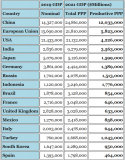Ok. I'm not well versed in economics so can you tell me what are the drawbacks of Fed increasing interest rates and what effects does it have on US economy? Because despite China growing faster than the US, nominal GDP gap has still increased due to dollar value increasing. But clearly, there should be a drawback for this??
You have to pay back the interest money since most of the debt is owned by the US, not foreign countries. Why do you think the Federal Reserve had its first layoff in a decade?

